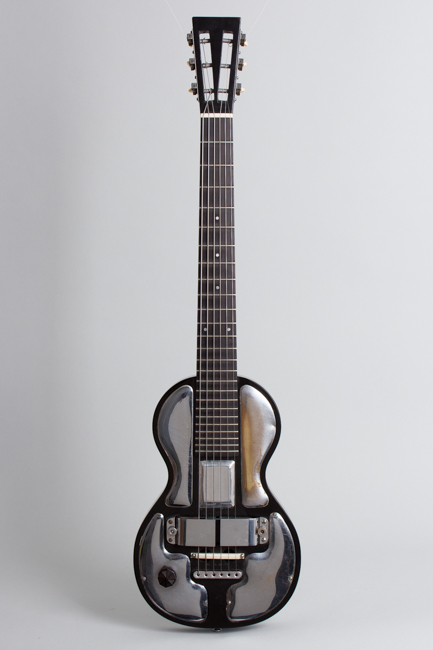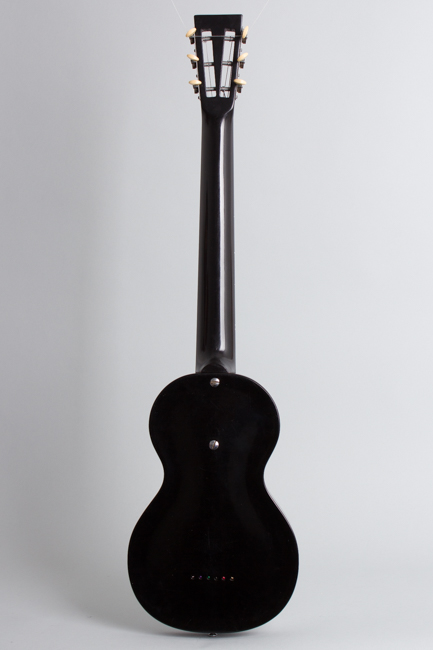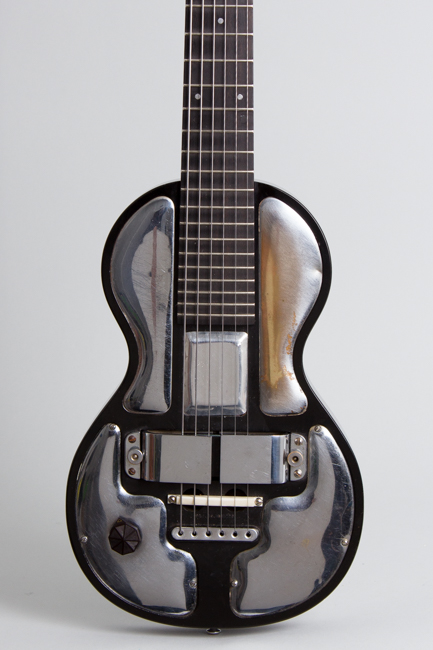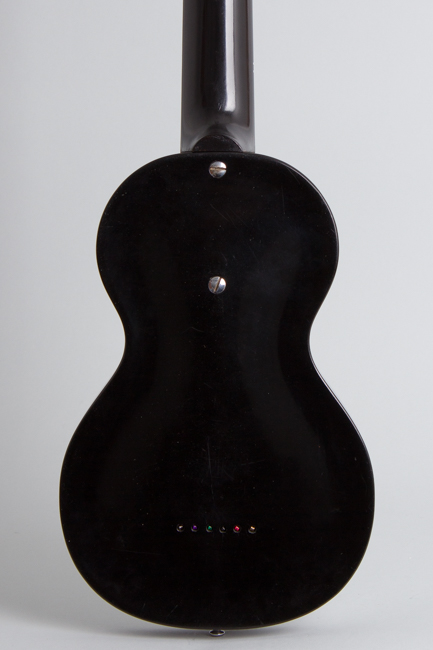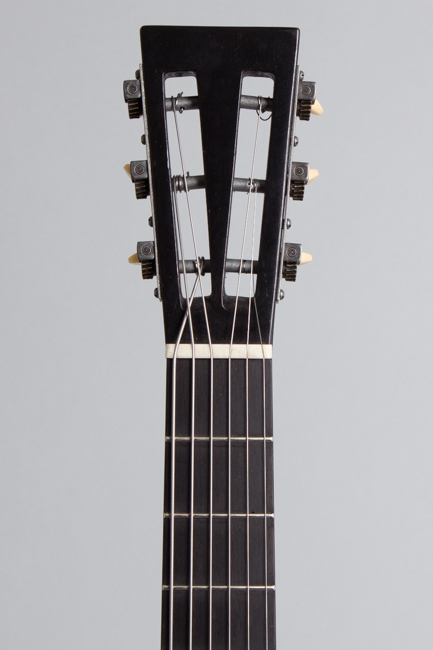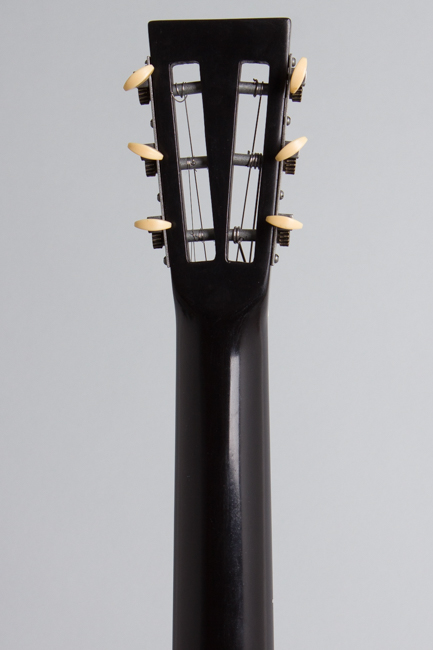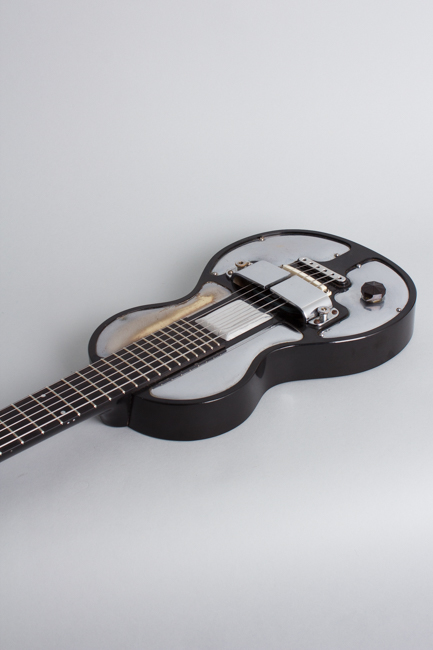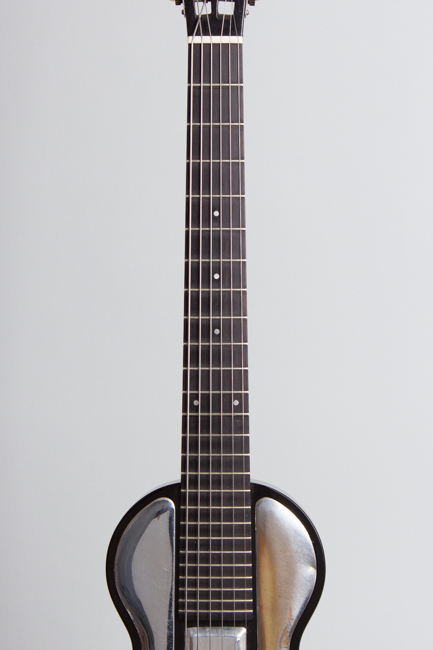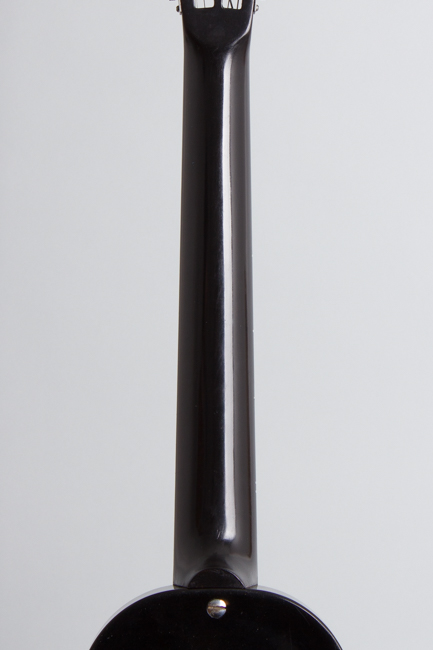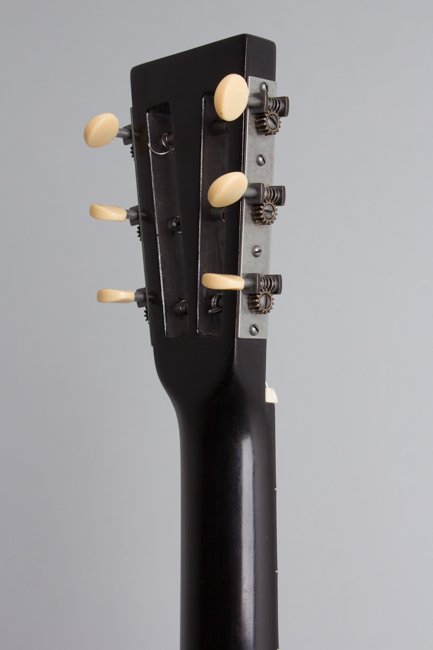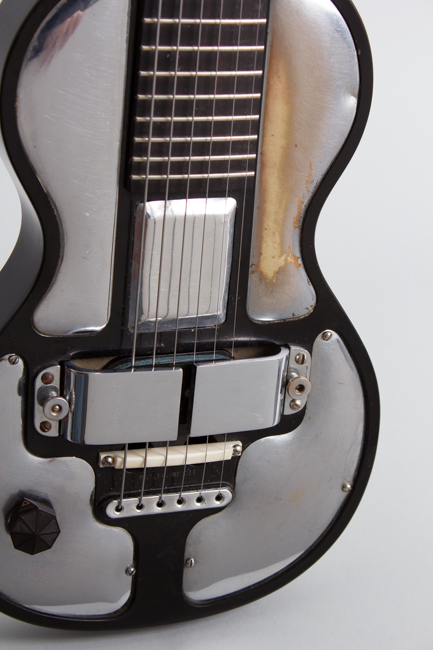Rickenbacker Electro Spanish w/Custom Neck Solid Body Electric Guitar , c. 1935
Rickenbacker Electro Spanish w/Custom Neck Model Solid Body Electric Guitar, c. 1935, made in Los Angeles, polished black finish, molded Bakelite body; maple neck with ebony fingerboard, black gig bag case.
This is a very special example of one of the most historically interesting of all American electric guitars, the first commercially important electric standard model: the Rickenbacker Electro Spanish. This example is not all original; it has a beautiful "Retrofret Special" wooden neck instead of the original molded Bakelite neck with integral frets. This transforms this usually marginally useable vintage collectible into a fine playing instrument. It is a really cool and unique player's piece now, harnessing the amazing sound of this greatest of all early pickups into an eminently more usable package.
Introduced in 1935 at the same time as the Model B Electro Hawaiian Guitar, the Electro Spanish Guitar was not nearly as successful subsequently seeing only limited production. In the 1930s Rickenbacker offered several rather klunky wooden-bodied Spanish electrics but this is their most radical, earliest, and purest attempt at a solid-body fully electric Spanish guitar, well before there was a market for such an instrument.
The Electro Spanish was followed by the Vibrola Spanish with an internal motorized vibrato device. Clayton Orr "Doc" Kauffman invented this system, and the Fender Broadcaster designed a few years after Kauffman's partnership with Fender carries on several features of the Electro-Spanish guitar including the bolt-on neck (considered an easily replaceable part), the through-body stringing, and the bridge-mounted steel-guitar position pickup. The Electro-Spanish can be seen as the progenitor of the entire California family of solid-body guitars to come.
This is an early example; specific features include a single octagonal volume knob and output jack both on the bass side. The molded black Bakelite body has five cavities covered by decorative chrome plates; the top three are not screwed in but held in place with hide glue. The strings run through the body and emerge from a molded block just behind the bridge. The horseshoe magnet pickup wraps over the strings and has the famed pre-war 1-1/2" wide magnets; the mounting bracket has "Pat. Pend" on the treble side flange. The Patent number 1881229 is molded in raised letters on the body below the bridge.
The more recent detachable neck is made of maple with a ebony fretboard; the contour is similar to the original Bakelite neck as are the small metal dot inlays. It has a 24" scale and joins the body at the 15 1/2 fret, with 25 frets total. This scale length while shorter than most modern electrics (though common on 1960s Harmonys) preserves the balance of the small body better than a longer neck. This is bolted to the body with two large screws. The headstock is slotted (for a better break angle over the nut) in the style of an old Stella. The tuners are modern vintage style openback strips. The neck finish almost uncannily matches the polished Bakelite of the body.
The Electro-Spanish is quite rare; few players today have even handled one. When this one arrived with a badly damaged neck it seemed like a no-brainer to customize the instrument retaining the original sound with a player-friendly feel. The heavy Bakelite body and horseshoe magnet pickup combine to produce an extremely powerful singing tone familiar to steel guitarists who still prize the Bakelite Hawaiian guitar, but virtually unique in a Spanish guitar. Although no longer a museum-grade collector's piece, this customized Electro-Spanish Guitar is a wonderful musical instrument, albeit still an eccentric one. It sounds wonderful for standard play and is (unsurprisingly) a fantastic slide guitar.
Overall length is 34 in. (86.4 cm.), 9 1/4 in. (23.5 cm.) wide at lower bout, and 1 3/4 in. (4.4 cm.) in depth, measured at side of rim. Scale length is 24 in. (610 mm.). Width of nut is 1 3/4 in. (44 mm.).
The original 1935 components of this guitar show some typical wear and tear, but overall this is a relatively well preserved example. There is notable wear to the chrome on the plate below the fingerboard through to the metal below, and all the plates show some scuffing and scratches. The small center plate is a functional but inexact replacement. The pickup appears original, with the coil wrapped in ancient blue cord. It sounds fantastic, and the volume control is more useful than on many electrics though oddly placed to the modern player.
The neck and frets are basically new and unworn. The nut and (replaced) bridge are bone; the bridge attaches to the body with two screws other options could easily be substituted. There is a neat metal plate added over the string holes in the top to facilitate grounding. This instrument sounds fantastic, looks great and is fully playable to a modern standard, something the originals with Bakelite necks and molded frets virtually never are. While we usually prefer original unmodified instruments this is a special case, a lovely early historic guitar made useable in the modern world without betraying its roots. Overall Excellent - Condition.
This is a very special example of one of the most historically interesting of all American electric guitars, the first commercially important electric standard model: the Rickenbacker Electro Spanish. This example is not all original; it has a beautiful "Retrofret Special" wooden neck instead of the original molded Bakelite neck with integral frets. This transforms this usually marginally useable vintage collectible into a fine playing instrument. It is a really cool and unique player's piece now, harnessing the amazing sound of this greatest of all early pickups into an eminently more usable package.
Introduced in 1935 at the same time as the Model B Electro Hawaiian Guitar, the Electro Spanish Guitar was not nearly as successful subsequently seeing only limited production. In the 1930s Rickenbacker offered several rather klunky wooden-bodied Spanish electrics but this is their most radical, earliest, and purest attempt at a solid-body fully electric Spanish guitar, well before there was a market for such an instrument.
The Electro Spanish was followed by the Vibrola Spanish with an internal motorized vibrato device. Clayton Orr "Doc" Kauffman invented this system, and the Fender Broadcaster designed a few years after Kauffman's partnership with Fender carries on several features of the Electro-Spanish guitar including the bolt-on neck (considered an easily replaceable part), the through-body stringing, and the bridge-mounted steel-guitar position pickup. The Electro-Spanish can be seen as the progenitor of the entire California family of solid-body guitars to come.
This is an early example; specific features include a single octagonal volume knob and output jack both on the bass side. The molded black Bakelite body has five cavities covered by decorative chrome plates; the top three are not screwed in but held in place with hide glue. The strings run through the body and emerge from a molded block just behind the bridge. The horseshoe magnet pickup wraps over the strings and has the famed pre-war 1-1/2" wide magnets; the mounting bracket has "Pat. Pend" on the treble side flange. The Patent number 1881229 is molded in raised letters on the body below the bridge.
The more recent detachable neck is made of maple with a ebony fretboard; the contour is similar to the original Bakelite neck as are the small metal dot inlays. It has a 24" scale and joins the body at the 15 1/2 fret, with 25 frets total. This scale length while shorter than most modern electrics (though common on 1960s Harmonys) preserves the balance of the small body better than a longer neck. This is bolted to the body with two large screws. The headstock is slotted (for a better break angle over the nut) in the style of an old Stella. The tuners are modern vintage style openback strips. The neck finish almost uncannily matches the polished Bakelite of the body.
The Electro-Spanish is quite rare; few players today have even handled one. When this one arrived with a badly damaged neck it seemed like a no-brainer to customize the instrument retaining the original sound with a player-friendly feel. The heavy Bakelite body and horseshoe magnet pickup combine to produce an extremely powerful singing tone familiar to steel guitarists who still prize the Bakelite Hawaiian guitar, but virtually unique in a Spanish guitar. Although no longer a museum-grade collector's piece, this customized Electro-Spanish Guitar is a wonderful musical instrument, albeit still an eccentric one. It sounds wonderful for standard play and is (unsurprisingly) a fantastic slide guitar.
Overall length is 34 in. (86.4 cm.), 9 1/4 in. (23.5 cm.) wide at lower bout, and 1 3/4 in. (4.4 cm.) in depth, measured at side of rim. Scale length is 24 in. (610 mm.). Width of nut is 1 3/4 in. (44 mm.).
The original 1935 components of this guitar show some typical wear and tear, but overall this is a relatively well preserved example. There is notable wear to the chrome on the plate below the fingerboard through to the metal below, and all the plates show some scuffing and scratches. The small center plate is a functional but inexact replacement. The pickup appears original, with the coil wrapped in ancient blue cord. It sounds fantastic, and the volume control is more useful than on many electrics though oddly placed to the modern player.
The neck and frets are basically new and unworn. The nut and (replaced) bridge are bone; the bridge attaches to the body with two screws other options could easily be substituted. There is a neat metal plate added over the string holes in the top to facilitate grounding. This instrument sounds fantastic, looks great and is fully playable to a modern standard, something the originals with Bakelite necks and molded frets virtually never are. While we usually prefer original unmodified instruments this is a special case, a lovely early historic guitar made useable in the modern world without betraying its roots. Overall Excellent - Condition.
